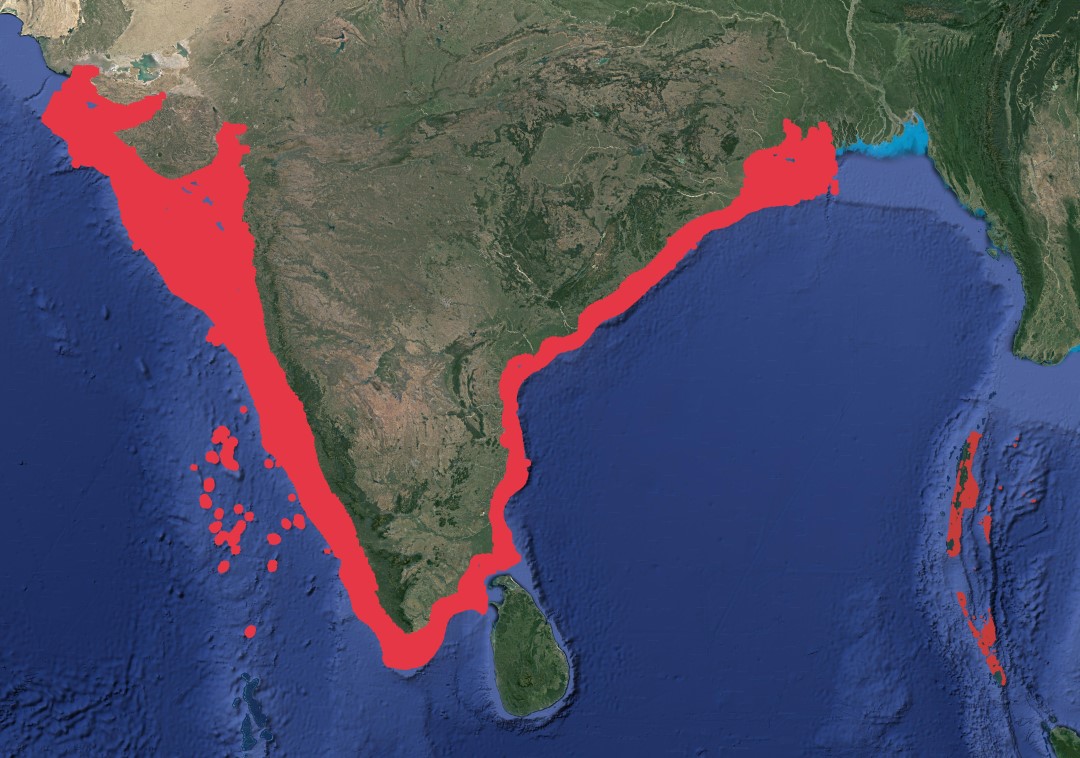Species Name
Spot-tail Shark
Scientific Name
Carcharhinus sorrah
Family Name
Carcharhinidae
IUCN Status
Near Threatened
A small, spindle sharped shark with a long, rounded snout; first dorsal fin can be plain or slightly black-edged; second dorsal fin, pectoral fins and lower caudal fin with distinct black tips; a conspicuous white band on plank present.
Biology
Length: Carcharhinus sorrah can reach a maximum length of around 2.5 meters (8.2 feet). However, the typical adult size is generally between 1.5 to 2 meters (4.9 to 6.6 feet) in length.
Gestation period: 10 to 12 months Littter size: This species is viviparous, which means that live young are born. Carcharhinus sorrah normally has litter sizes between 4 and 16, but this might change based on the size and age of the female, among other things. normally has litter sizes between 4 and 16, but this might change based on the size and age of the female, among other things.
Life Expectancy: The life expectancy of Carcharhinus sorrah in the wild is estimated to be around 8 years.
Diet: The predatory spot-tail shark has a diversified food and is a carnivore. It mostly eats small bony fish, crustaceans, and cephalopods (like squid and octopuses). Given the opportunity, they will eat any available prey in their habitat because they are opportunistic feeders.
Habitat and Distribution
Habitat: Carcharhinus sorrah is a coastal and pelagic species that can be found in both marine and brackish environments. They prefer warm waters and are often associated with coral reefs, estuaries, river mouths, and coastal bays. These sharks are known to be relatively common in shallow coastal areas but can also venture into deeper waters.
Distribution: The spot-tail shark has a wide distribution across the Indo-West Pacific region. It can be found along the coasts of numerous countries, from the eastern coast of Africa to the western Pacific Ocean. Specifically, its distribution ranges from the Red Sea and East Africa to the coast of India, Southeast Asia, and northern Australia. This species is commonly encountered in the waters of countries like India, Thailand, Indonesia, Malaysia, Philippines, Papua New Guinea, and Australia. Depth: Carcharhinus sorrah typically inhabits shallow coastal waters but can also occur in deeper offshore areas. It is often found at depths ranging from 0 to 50 meters (0 to 164 feet), though it has been recorded at depths of up to 100 meters (328 feet).
Known landing centres: Satpati, Sassoon Dock, New Ferry Wharf, Royapuram Fishing, Harbour, Cuddalore Fishing Harbour, Nagapattinam Fishing Harbour, Thoothukudi, Threshpuram, Tharuvaikulam, Vembar, Vellapatti, Junglighat, Burmanallah, Wandoor, Dignabad, Cochin Fisheries Harbour, Satpati, Sassoon Dock, New Ferry Wharf, Veraval, Mangrol, Porbander, Okha, Kakdwip.
Commercial Value
They are regularly caught by local artisanal and small-scale commercial fisheries ; utilised as food once landed, liver used for vitamin oil.
Threats
Overfishing, exploitation and intense fishing pressure by the fishing industry; among both sexes females are exposed to more severe fishing pressure than males.
References
- Compagno, L.J.V., 1984. FAO Species Catalogue. Vol. 4. Sharks of the world. An annotated and illustrated catalogue of shark species known to date. Part 2 - Carcharhiniformes. FAO Fish. Synop. 125(4/2):251-655. Rome: FAO.
- Harry, Alastair & Tobin, Andrew & Simpfendorfer, Colin. (2013). Age, growth and reproductive biology of the spot-tail shark, Carcharhinus sorrah, and the Australian blacktip shark, C. tilstoni, from the Great Barrier Reef World Heritage Area, north-eastern Australia. Marine and Freshwater Research. 64. 277-293. 10.1071/MF12142.
- Knip, D. M., Heupel, M. R., & Simpfendorfer, C. A. (2012). Habitat use and spatial segregation of adult spottail sharks Carcharhinus sorrah in tropical nearshore waters. Journal of fish biology, 80(4), 767–784. https://doi.org/10.1111/j.1095-8649.2012.03223.x


Related Species
- Tiger Shark
- Silky Shark
- Blacktip Reef Shark
- Common Blacktip Shark
- Milk Shark
- Spadenose Shark
- Bignose Shark
- Blackspot Shark
- Blue Shark
- Broadfin Shark
- Bull Shark
- Dusky Shark
- Ganges Shark
- Graceful Shark
- Grey Reef Shark
- Grey Sharpnose Shark
- Hardnose Shark
- Sliteye Shark
- Silvertip Shark
- Sharptooth Lemon Shark
- Sandbar Shark
- Pondicherry Shark
- Pigeye Shark
- Oceanic Whitetip Shark
- Irrawaddy River Shark
- Speartooth Shark
- Spinner Shark
- Whitecheek Shark
- Whitetip Reef Shark

